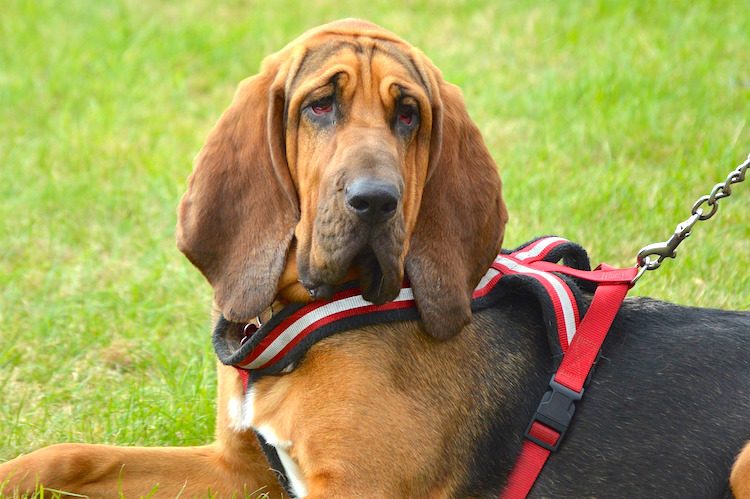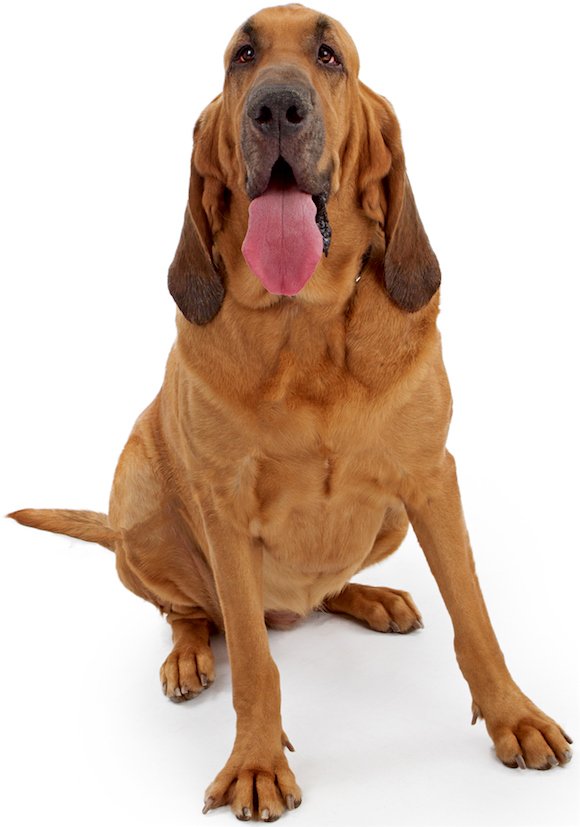
Hound
90-110 lbs. (male);
80-100 lbs. (female)
25-27 in. (male);
23-25 in. (female)
10-12 years
1. Key Characteristics of Bloodhounds
Bloodhounds are powerful, large scent hounds known for their tracking abilities.
The “blood” in the name refers to breeders working hard to preserve the lineage, not because the dog tracks blood.
The dogs’ floppy ears, diamond-shaped eyes and wrinkled skin give them an unmistakable appearance. The short coat comes in black and tan, liver and tan, and red. Some dogs may have flecks of white.
2. Where Bloodhounds Came From
This ancient breed may be more than 1,000 years old. Claudius Aelianus wrote about a dog in the third century who tracked better than any other dog and stayed focused until the scent match was found.
The first Bloodhounds to enter Europe were reportedly brought in from Constantinople.
There were black and white lines of the hounds called the St. Huberts (black) and Southern Hounds (white). The St. Huberts line was the first to be exported to England. English hunters used the dogs to track game.
Bloodhounds were greatly developed in the United States and known to assist law enforcement agencies. According to the American Kennel Club (AKC), a Bloodhound’s tracking ability is so accurate it is accepted as evidence in legal cases.
The AKC added the breed in 1885.

3. How Friendly Are Bloodhounds?
These large scent hounds are affectionate, patient, gentle and devoted to their people.
Bloodhounds are great with children and get along with other pets. On the negative side, these hounds have a tendency to snore, drool and howl.
They are independent and determined, especially when they focus on a scent. Bloodhounds are known to get distracted by smells, so keep yours in a fenced yard or on a leash outside the yard.
These dogs can follow any scent — human scent included. As such, yours will need firm and consistent training.
4. Is This the Right Dog for You?
Exercise Needs
HIGH: If you like to walk or jog, a Bloodhound would be happy to go along. These dogs have a high need for exercise, and their stamina allows them to walk long distances.
But don’t overexercise them during their body’s development — they grow fast. Bloodhounds do well in apartments if their exercise needs are met.
Grooming Needs
MEDIUM: The Bloodhound’s coat is short and easy to groom. Bathe yours as necessary.
Other regular grooming, however, is essential:
- Check and clean those long, floppy ears as well as the skin folds on the coat.
- The nails may get some wear and tear through daily exercise, but you probably want to trim them weekly.
- And, of course, clean your dog’s teeth regularly.
Health Problems
MEDIUM: Health problems associated with Bloodhounds include:
- Bloat
- Stomach cramps
- Hip dysplasia
- Cherry eye
- Ear infections
- Eyelid problems (entropion)
- Calluses
More Stats About Bloodhounds
| Friendliness | ★★★★★ |
| Ease of Training | ★★★☆☆ |
| Barking/Howling | ★★★★☆ |
| Shedding | ★★★★☆ |
| Tolerate Being Alone | ★★☆☆☆ |
| Very Good With Kids | ★★★★★ |
Learn more about Bloodhounds in this video:

5. How to Adopt a Bloodhound
Bloodhounds can end up in shelters and rescues. Search these resources first, or inspect breeders for warning signs of a puppy mill.
References
- “Bloodhound.” American Kennel Club. https://www.akc.org/dog-breeds/bloodhound/.
- “Breed History and Standard.” American Bloodhound Club. https://www.americanbloodhoundclub.org/breed-history-standard/.
- “Health Tests.” American Bloodhound Club. https://www.americanbloodhoundclub.org/recommended-health-tests/.
- Warren, Dean Marvin. Small Animal Care & Management, Second Edition. Delmar. 2002. 78.








